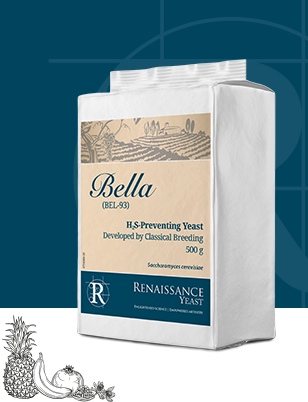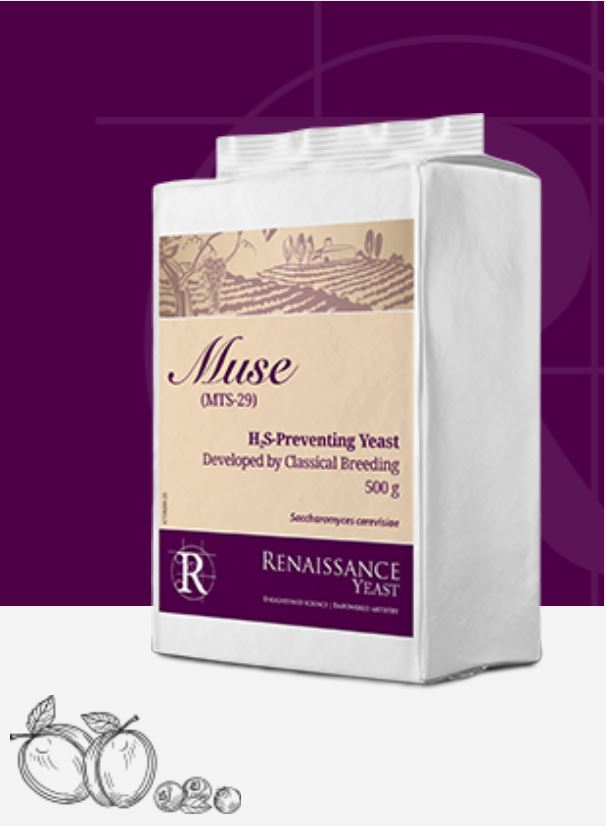Innovative
H2S
Prevention
Negative volatile sulfur compounds
Hydrogen sulphide (H2S) is responsible for the distinctive smell of rotten eggs and is usually formed naturally by yeast during wine fermentation. Even in trace amounts, the presence of H2S prevents the expression of the wines full flavor, aroma and personality.
The trait to prevent H2S during fermentation was discovered in a yeast from a vineyard in the North of Italy. It’s this natural isolate that is used as base for the selective breeding of RENAISSANCE™ wine yeast strains.
Why
is it so important to prevent H2S
production?
SENSORY THRESHOLD
Low reported sensory threshold is 9.0 – 1.5 ppb. Below sensory threshold in wine will mask fruit expression and character.
PROBLEMS
Several other defect-causing volatile sulfur compounds may develop from initial chemical modification of H2S.
MERCAPTANS
burnt rubber, garlic, rotten cabbage
- Likely formed in reactions involving H2S
DISULFIDES
burnt rubber, garlic, cabbage, onion-like
- Formed from oxidation of sulfide or mercaptan precursors
- Very difficult to remove from wine and can revert to mercaptans
PREVENTION & SOLUTION
Initial prevention of H2S formation during fermentation is critical part of the control strategy to prevent volatile sulfur compound formation. Once a wine is tainted with H2S, all potential elimination (i.e. aeration, copper) influence wine quality.
The easiest, most effective and safest way of prevention is to rely on RENAISSANCE™ yeasts for the fermentation of your wines. They also allow you to achieve excellent oenological performance and high quality levels of your wines.
RENAISSANCE™ yeast strains
Allegro

Ester production for aromatic whites.
Avante

For fruity reds.
Bella

For terpenic whites - Harsh conditions .
Bravo

For high glycerol reds.
Brio

For youthful reds & Pinot Noir.
Muse

For fruity reds with color & structure.
TR-313

For varietal whites - Thiols release.
Viva

For elegant, crisp & lively whites.
Fresco

For cider.
Comparative trial results

Ethyl ester production in Chardonnay

Sensory profile in Cabernet-Sauvignon

Sensory profile in Sauvignon Blanc
Questions & Answers
What is RENAISSANCE™’s hydrogen sulfide-preventing yeast?>
Developed through classical natural breeding, RENAISSANCE™ yeast do not produce hydrogen sulfide during fermentation, but are otherwise identical to comparable traditional wine yeast. RENAISSANCE™ yeast are a preventative solution to the hydrogen sulfide problem in winemaking.
Are RENAISSANCE™ hydrogen sulfide-preventing yeast GMO?>
No. RENAISSANCE™ yeasts have been developed by classical natural breeding in which the H2S-preventing trait has been bred into traditional quality wine yeasts.
How do I inoculate RENAISSANCE™ yeast?>
Exactly like all other active dry yeasts (ADY).
How does the viability of RENAISSANCE™ hydrogen sulfide-preventing yeast compare to other active dry yeast (ADY) >
RENAISSANCE™ yeast are manufactured to the highest standard. When used according to instructions, yeast viability is in excess of 10 billion live cells per gram dry weight.
What is the shelf life of RENAISSANCE™ hydrogen sulfide-preventing yeast?>
The shelf life is clearly indicated on the product packaging and is 4 years from the date of manufacture.
What package sizes do you offer?>
Our products come in 500g and 10kg packages.
Where
can you find these products?
For USA and Canada, please contact
- Phone (866) 213 1131
- Email sales@gusmerenterprises.com
- Website www.gusmerenterprises.com









